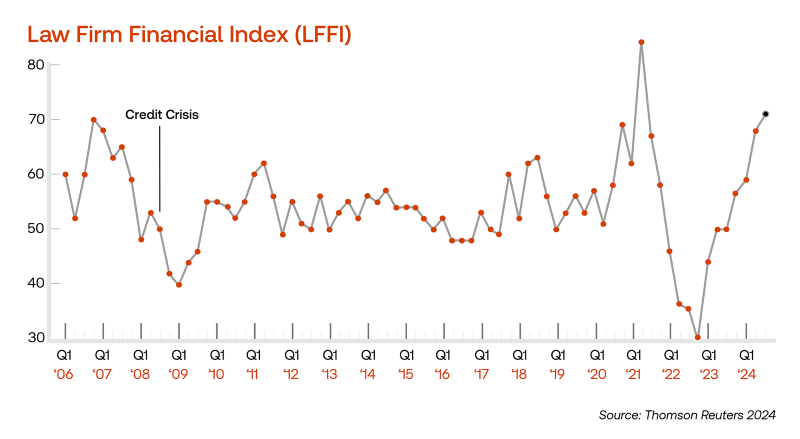Law firms look solid as they near the end of the year, balancing expansion with productivity gains, expense growth with revenue growth, and risk with reward
There has been significant growth in the financial health of law firms, driven by a resurgence in demand and further gains in productivity, according to the Thomson Reuters® Institute Law Firm Financial Index (LFFI) for the third quarter of 2024.
Indeed, the Q3 2024 LFFI rose 4 points to a score of 71, the second-highest score of all time.
Key takeaways in Q3
-
-
- The LFFI score reached a level that’s only eclipsed by what was seen in by early-2021.
- Demand growth was incredibly broad, with diverse practice areas showing increased levels of performance.
- Law firms are in a fundamentally stronger position compared to previous peaks.
-
The Index score marks seven consecutive quarters of progress for law firms, with this improvement evident across all areas measured by the LFFI. Perhaps most notably, productivity continued to rise, with almost two-thirds of firms experiencing growth in Q3 2024.
From a demand perspective, most major practice areas experienced growth. Transactional demand continued to rise to its best performance since early 2022; and counter-cyclical practices — such as litigation, real estate, labor & employment, and corporate work — led the way in terms of growth pace. Importantly, transactional demand also returned to growth mode, contributing significantly to overall firm performance.

The remarkable growth in worked rates seen in in the first two quarters of this year continued in Q3. This outcome led fees worked to experience one of the fastest accelerations since our data tracking began. This performance was achieved due to both the strength of counter-cyclical practices and the revival of transactional ones.
It is also worth mentioning that the transactional practice areas saw a considerable increase in fees in Q3 thanks to higher billing rates, as the dual growth in both transactional and counter-cyclical practices has provided a more sustainable revenue stream for law firms.
Securing a more stable position
Compared to the last time the legal industry experienced similar high performance; law firms today are in a much more stable position. The previous wave of high transactional demand occurred amid a strong stimulus-driven economy in the United States, which aimed to address the economic stress from the pandemic but was also undergoing a surge of inflation caused by global supply chain disruptions.
Today, law firms may not be experiencing the same rapid demand growth as they did during the post-pandemic transactional boom, but the growth they are seeing is more sustainable due to its diversification. With faster worked-rate growth, and firms no longer recovering from pandemic-induced lows, the current pace of revenue growth appears more solid and multifaceted.
Compared to the last time the legal industry experienced similar high performance; law firms today are in a much more stable position.
From the expenses side of the ledger, improvement was evident, too. Direct and overhead expenses saw a slight acceleration in Q3, yet these levels are lower compared to those seen in the previous transactional boom and are not pair with economic inflation, demonstrating that firms may be pursuing market opportunities rather than experiencing stifling levels of inflation. And despite firms not enjoying the same acceleration in profit growth they achieved previously, they are also not as heavily leveraged to achieve such gains. In fact, many law firms are operating on more secure foundations, enabling them to maintain success over a longer period.
Overall, the Q3 2024 LFFI report outlines an industry on a solid path to continued financial health, with diverse demand growth across different practice areas and more sustainable expense management. This positive trajectory suggests that law firms may be well-positioned for sustained success in the near future.
You can download a full copy of the Thomson Reuters® Institute Law Firm Financial Index report for the third quarter of 2024 by filling out the form below:







